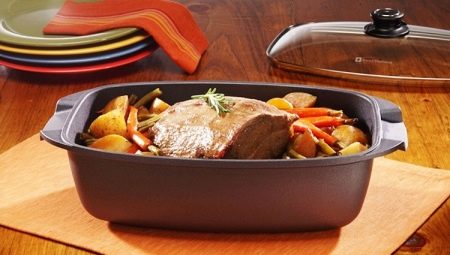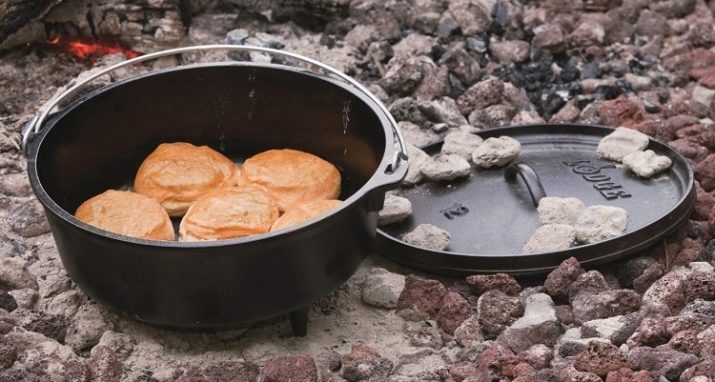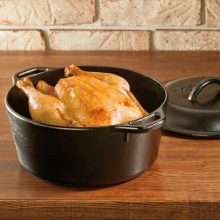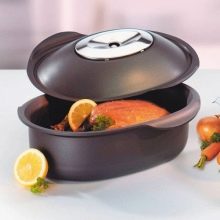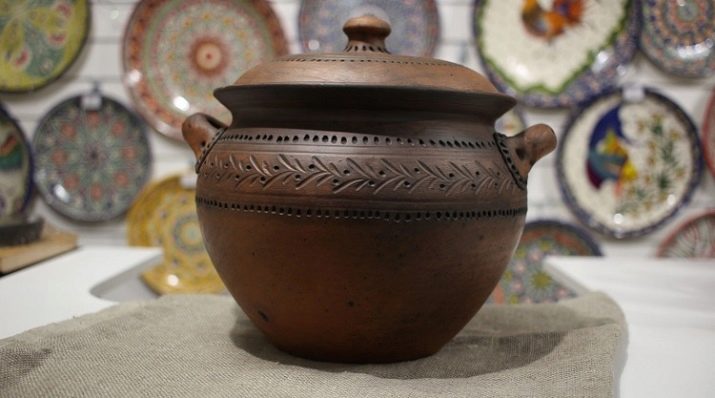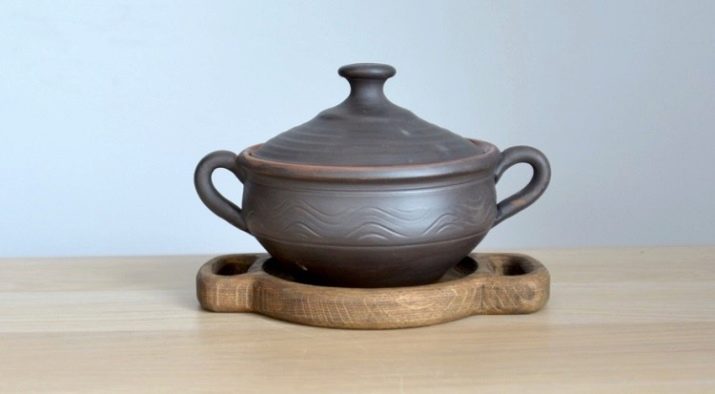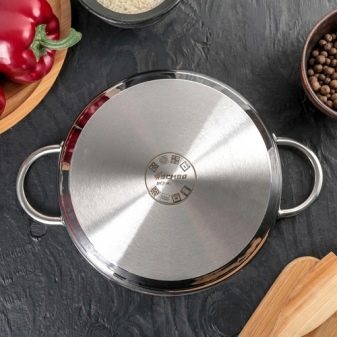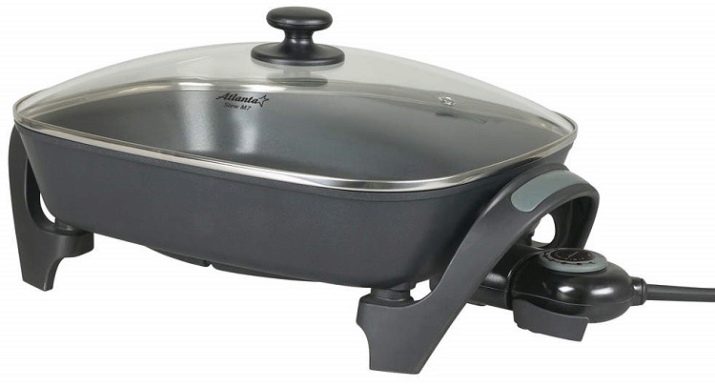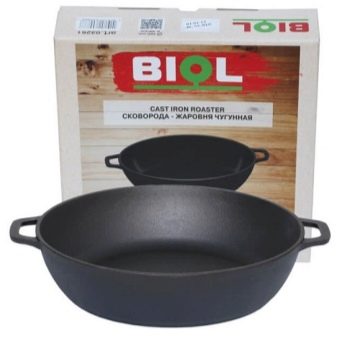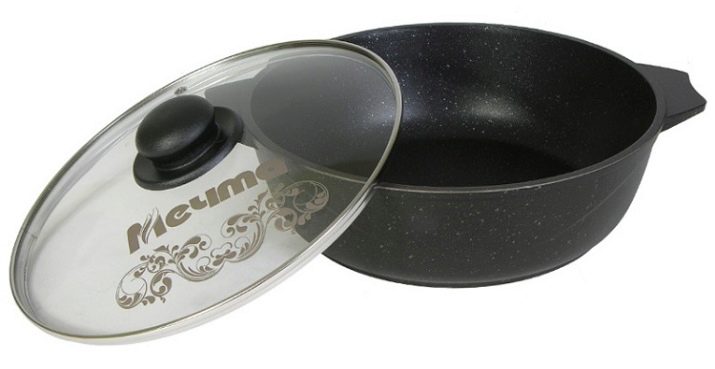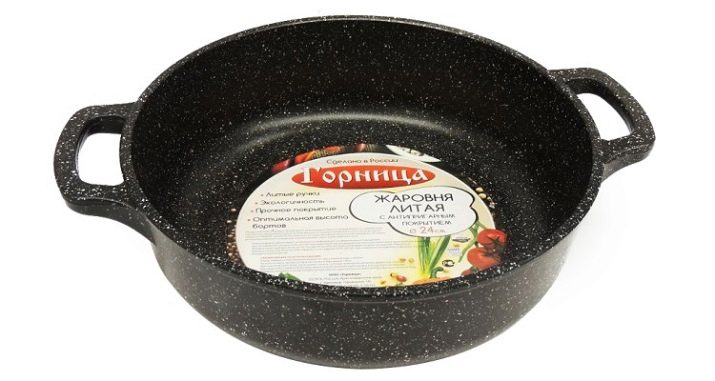A roasting pan can be found not in every kitchen, but those who decide to purchase it quickly appreciate the value of a purchase. With this dish you can cook delicious meat, poultry, vegetables. Braziers are different from cauldrons and pots for roasting, they have different types and purpose, and what we have to figure out in this article.
Features
A roaster is a type of pan. It can fry meat and fish products, sauté vegetables, it copes well with stewing any dishes and baking bread. It differs from a conventional frying pan in speed and high quality quenching. This effect is created by thick walls and bottom with a large working surface. The heat is distributed gradually and evenly, which allows the dish, without burning, to stew well.
Another advantage of the brazier is the possibility of baking food. The presence of small heat-resistant side handles allows you to easily place the product in the oven.
An important addition to the grill is a lid. It is tight, without gaps installed on the surface of the dish and creates the effect of convection inside the container, which contributes to the rapid and uniform heating. The lid may not coincide on the production material with a brazier, it is glass, stone, aluminum. They are released flat and convex, they always repeat the shape of the dishes.
And the shape of the brazier can be very different:
- in the round it is convenient to extinguish vegetables;
- square need for frying meat;
- bake whole fish, duck or goose in the oval. They are called so-utyatnitsy or gosyatnitsy.
Varieties
The prototypes of modern braziers were containers that our ancestors used to cook on an open fire. Some modern products and today can perform a similar function, they can be used during outdoor recreation. But in most cases they are used for cooking on a gas, induction or electric stove, as well as in the oven.
Chafing dishes can be divided into two main types.
- Deep table pan with a thick wide bottom and high walls, with a tight-fitting lid.
- Stewpan - above the pan, but just below the pan. Such braziers come in different shapes - in the form of pots, or oval goosenecks with a heavy lid.
Particularly worth highlighting the roaster for induction furnace. The bottom of such products has a special addition that allows them to be susceptible to a magnetic field and have enhanced thermal conductivity. Choosing induction cookware, you should pay attention to the parameters of its bottom and the size of the burners.
Interesting opportunities are the braziers, which are called unglazed. They have a porous structure, they should be soaked before use to saturate the walls with moisture.
In the process of cooking, the moisture will be transferred to food and make the dish tender and juicy.
Material
Modern industry uses for the manufacture of braziers different materials. In addition to various grades of metal, glass, clay, ceramics, as well as additional coatings are used.
Cast iron
This metal was used for kitchen utensils by our ancestors. It is environmentally friendly and with proper operation has no shelf life. Massive bottom and walls of cast iron products contribute to fast and high-quality cooking of dishes, which are languishing in their own juice.
Cast iron belongs to porous metals and at first absorbs vegetable oil and animal fats into the walls. But a natural non-stick layer is gradually formed, and the consumption of fat during cooking is significantly reduced. Sometimes produce models coated with heat-resistant enamel, in this case, oil consumption decreases immediately. Today, our grandmothers prefer cast iron to all modern materials.
The disadvantages of such products include heavy weight. The material reacts to an acidic environment and can change the taste of dishes with tomato, lemon juice or vinegar.
It is not recommended to store cooked foods in cast-iron stewpots, it is better to immediately transfer them to food containers.
Titanium
The weight of titanium products is close to cast iron. They respond well to an acidic environment and do not change the taste of food when adding tomatoes or stewing sauerkraut. Pthe lot walls of the product hold the uniform temperature well and for a long time, Meals are cooked easily, they are succulent.
The inconvenience of a titanium brazier is only one - it can not be washed in a dishwasher.
Aluminum
For the manufacture of aluminum grills using high pressure casting. Apply food, harmless metal. You should choose a forged product with thick walls, necessarily cast or having a ceramic layer.
Thin lightweight extruded aluminum models are the worst choice of brazier.
Stainless steel
Such a roaster is considered universal, it is used for cooking meat, fish, vegetables, baking, etc. It is possible to keep cooked dishes for a long time, the taste of which stainless steel will not change. The product is lightweight and durable, good care.
If the model has a non-stick coating, abrasives are not recommended.
Despite the high performance, many housewives prefer all the same cast-iron saucepans, evaluating the cooking in them as better.
Clay
Such a product can be used both on the stove and on an open fire. Clay is an environmentally friendly, harmless product.
Dishes cooked in a brazier retain their natural qualities and natural taste.
Ceramics
This material is used to make braziers or to cover metal products. If the model is completely made of ceramics, the food cooked in such a stewpot will be unusually tasty, as well as in clay pots. Such material creates an alkaline environment and neutralizes acidity, giving a peculiar taste to sour dishes. But the product itself requires careful handling, it can break or crack on an open fire.
It is more convenient to use metal models coated with a ceramic layer. It will protect food from contact with metal and allow preserving the natural taste of the product during extinguishing. Some believe that food cooked in ceramic or pottery will never cause heartburn.
Such products have a beautiful appearance and are worthy of becoming an ornament to any kitchen.
Glass
For the production of glass roaster use special heat-resistant glass (Pyrex), which can withstand temperatures up to 400 degrees. Choose a stewpan should be with thick walls.
In stew-boxes made of heat-resistant glass, you can not only stew meat and poultry, but also cook porridge, make omelets, bake cakes. The glass firebox is made with small glass handles or without handles at all. They are used in ovens, on all kinds of cookers and in the microwave.
Choosing a product, you should pay attention to the fact that the glass was as thick as possible and did not have cavities inside.
Glass ceramics
Since the glass contains elements of ceramics, the material is not transparent, it looks like porcelain, but is more durable and heat resistant.
This product looks very beautiful, it can be used for cooking on the stove and in the oven.
Review of the best models
South Korean, Thai, Italian braziers, as well as some models from domestic manufacturers are highly popular. After studying consumer reviews, we recommend to pay attention to the following options.
- "Gourmet". The classic look of braziers with a lid from the Russian manufacturer. Material - stainless steel, size - 20 cm. Can be used on gas, electric, induction and glass-ceramic surfaces, as well as in ovens. The thickened bottom evenly roasts the food, and after turning off the stove, it retains heat for a long time. Even not fully cooked dish, removed from the fire, will reach full readiness in a natural way. The product is suitable for washing in the dishwasher. The roaster is made of thick thick steel, weighs 1,250 g.
- Atlanta. Roomy electric chafing dish with cast-in handles, has a cover of heat-resistant glass (production - China). The cooking process is clearly visible through the transparent coating. The metal product is protected from overheating, endowed with a temperature controller, there is an indicator and a removable unit. Power - 1,700 W, capacity - 7 liters, wall thickness - 3 mm, height - 21 cm, weight - 4,760 g.
- "Biol". A cast-iron brazier with two handles, has a thickened bottom, accelerating the cooking process. The product is available in two sizes - with a diameter of 26 and 28 cm, has a bottom thickness of 4 mm, a wall thickness of 3.5 mm. The roaster is suitable for different types of stoves - gas, induction, ceramic, halogen, electric. The walls have a convenient angle, the model is designed for frying, stewing and baking any dishes.
- "Dream". A small cast aluminum brazier with a capacity of 3 liters from a domestic manufacturer. It is endowed with a multi-layer bottom of considerable thickness - 6 mm, wall thickness is 4 mm, weight - 2 130 g. The product with non-stick coating, is equipped with a glass cover with a hole for steam release. It is combined with electric, gas and glass-ceramic stove. Can be washed in the dishwasher.
- "Gornitsa". The brazier is made by the Russian company Gornitsa using the method of shaped casting of aluminum (chill casting). It has a high strength non-stick layer, not dangerous to health. The bottom is 5–6 mm thick, the walls are 4 mm thick, and the product weighs 2,650 g. The model is characterized by an enhanced heat capacity that ensures optimum temperature conditions at which food stews quickly and does not burn. The roaster is designed for gas, glass-ceramic and electric stoves.
- Frybest A small aluminum brazier produced in South Korea with a volume of 2 liters. Available in 3 colors - pink, brown, beige. The product looks elegant, has a good design. Aluminum is protected by a beautiful ceramic coating, the bottom has a good seal (6.5 mm). The lid effectively retains heat. A steam removal system is provided inside the brazier. Food is cooked quickly, without losing its beneficial properties.
Modern industry offers a large selection of braziers. The relatively high cost of the dishes may keep you from buying, but the price is compensated by the quick preparation of juicy, tasty dishes and the long service life of the product.
On how to properly care for iron cookware, you can learn from the following video.
